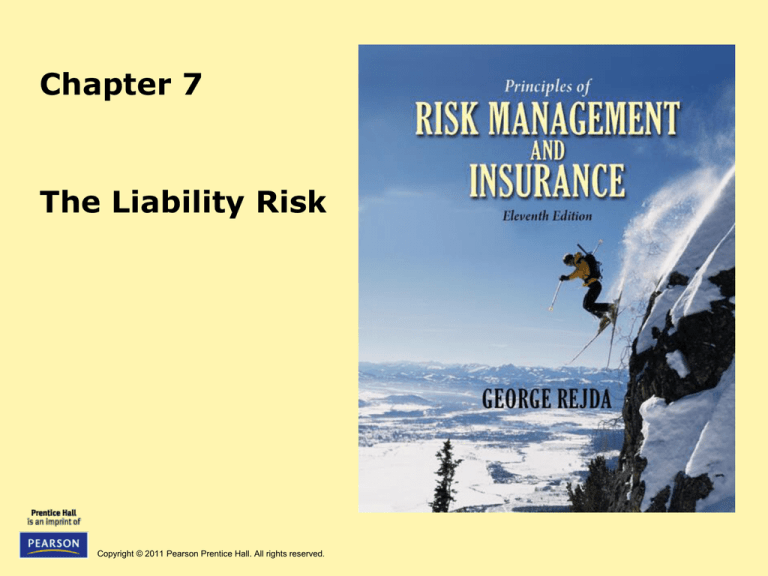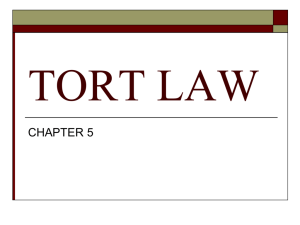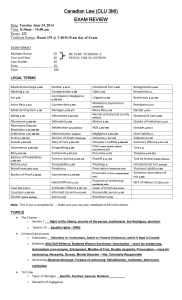
Chapter 7
The Liability Risk
Copyright © 2011 Pearson Prentice Hall. All rights reserved.
Agenda
•
•
•
•
•
Basis of Legal Liability
Law of Negligence
Imputed Negligence
Res Ipsa Loquitur
Specific Applications of the Law of
Negligence
• Current Tort Liability Problems
Copyright © 2011 Pearson Prentice Hall. All rights reserved.
19-2
Basis of Legal Liability
• A legal wrong is a violation of a person’s
legal rights, or a failure to perform a legal
duty owed to a certain person or to society
as a whole
• Legal wrongs include:
– Crime
– Breach of contract
– Tort
Copyright © 2011 Pearson Prentice Hall. All rights reserved.
19-3
Basis of Legal Liability
• A tort is a legal wrong for which the court allows a
remedy in the form of money damages
• The person who is injured (plaintiff) by the action of
another (tortfeasor) can sue for damages
• Torts fall into three categories:
– Intentional, e.g., fraud, assault
– Strict liability: liability is imposed regardless of negligence
or fault
– Negligence
Copyright © 2011 Pearson Prentice Hall. All rights reserved.
19-4
Law of Negligence
• Negligence is the failure to exercise the
standard of care required by law to protect
others from an unreasonable risk of harm
– The standard of care is not the same for each
wrongful act. It is based on the care required
of a reasonably prudent person
Copyright © 2011 Pearson Prentice Hall. All rights reserved.
19-5
Law of Negligence
• Elements Negligence
– Existence of a legal duty to use reasonable care
– Failure to perform that duty
– Damage or injury to the claimant
– Proximate cause relationship between the
negligent act and the infliction of damages
• A proximate cause relationship requires an unbroken
chain of events
Copyright © 2011 Pearson Prentice Hall. All rights reserved.
19-6
Law of Negligence
• The law allows for the following types of
damages:
– Compensatory damages compensate the victim
for losses actually incurred. They include:
• Special damages, e.g., medical expenses
• General damages, e.g., pain and suffering
– Punitive damages are designed to punish people
and organizations so that others are deterred
from committing the same wrongful act
Copyright © 2011 Pearson Prentice Hall. All rights reserved.
19-7
Law of Negligence
• The ability to collect damages for
negligence depends on state law
• Under a contributory negligence law, the
injured person cannot collect damages if
his or her care falls below the standard of
care required for his or her protection
– Under strict application of common law, the
injured cannot collect damages if his or her
conduct contributed in any way to the injury
Copyright © 2011 Pearson Prentice Hall. All rights reserved.
19-8
Law of Negligence
• Under a comparative negligence law, the financial
burden of the injury is shared by both parties
according to their respective degrees of fault
– Under the pure rule, you can collect damages even if you
are negligent, but your reward is reduced in proportion to
your fault
– Under the 50 percent rule, you cannot recover if you are 50
percent or more at fault
– Under the 51 percent rule, you cannot recover if you are 51
percent or more at fault
Copyright © 2011 Pearson Prentice Hall. All rights reserved.
19-9
Law of Negligence
• Some legal defenses can defeat a claim for
damages:
– The last clear chance rule states that a plaintiff
who is endangered by his or her own
negligence can still recover damages from the
defendant if the defendant has a last clear
chance to avoid the accident but fails to do so
– Under the assumption of risk doctrine, a person
who understands and recognizes the danger
inherent in a particular activity cannot recover
damages in the event of an injury
Copyright © 2011 Pearson Prentice Hall. All rights reserved.
19-10
Imputed Negligence
• Under certain conditions, the negligence of one
person can be attributed to another
– e.g., the negligent act of an employee can be imputed to
the employer
• Under a vicarious liability law, a motorist’s
negligence is imputed to the vehicle’s owner
• Under the family purpose doctrine, the owner of an
auto can be held liable for negligent acts committed
by family members
• Under a dram shop law, a business that sells liquor
can be held liable for damages that may result from
the sale of liquor
Copyright © 2011 Pearson Prentice Hall. All rights reserved.
19-11
Res Ipsa Loquitur
• Under this doctrine, the very fact that the injury or
damage occurs establishes a presumption of
negligence on behalf of the defendant
– Means, “the thing speaks for itself”
– e.g., a dentist extracts the wrong tooth
• Three requirements must be met for res ipsa
loquitur to apply:
– The event is one that normally does not occur in the
absence of negligence
– The defendant has exclusive control over the
instrumentality causing the accident
– The injured party has not contributed to the accident in any
way
Copyright © 2011 Pearson Prentice Hall. All rights reserved.
19-12
Applications of Negligence Law
• The standard of care owed to others depends upon
the situation
– A trespasser is a person who enters or remains on the
owner’s property without the owner’s consent
• The duty to refrain from injuring a trespasser is sometimes
referred to as the duty of slight care
– A licensee is a person who enters the premises with the
occupant’s expressed or implied permission
• E.g., a door-to-door salesperson
• The property owner must warn the licensee of unsafe
conditions or activities which are apparent
– An invitee is a person who is invited onto the premises for
the benefit of the occupant
• The occupant has an obligation to inspect the premises and
eliminate any dangerous conditions
Copyright © 2011 Pearson Prentice Hall. All rights reserved.
19-13
Applications of Negligence Law
• An attractive nuisance is a hazardous
condition that can attract and injure children
– The occupants of land are liable for the injuries of
children who may be attracted by some
dangerous condition, feature or article
– e.g., a building contractor leaves the keys in a
tractor, and a child is injured while driving it
Copyright © 2011 Pearson Prentice Hall. All rights reserved.
19-14
Applications of Negligence Law
• Owners and operators of automobiles who drive in a careless
manner can be held liable for property damage or bodily injury
sustained by another person
– An owner who is not the operator can be held liable for the acts of
operators if an agency relationship exists
• Today, governmental entities can be sued in almost every
aspect of governmental activity
– The doctrine of sovereign immunity has been modified over time
– A governmental unit can be held liable if it is negligent in the
performance of a proprietary function, e.g., the operation of water
plants
– Immunity from lawsuits for governmental functions, such as the
planning of a sewer system, has been eroded
• Charitable institutions are no longer immune from lawsuits,
especially with respect to commercial activities
Copyright © 2011 Pearson Prentice Hall. All rights reserved.
19-15
Applications of Negligence Law
• Under the doctrine of respondeat superior, an employer can be
held liable for the negligent acts of employees while they are
acting on the employer’s behalf
– The worker must be an employee
– The employee must be acting within the scope of employment
when the negligent act occurred
• A parent can be held liable if a child uses a dangerous weapon
to injure someone
• Most states have laws that hold parents liable for willful and
malicious acts of children that result in property damage to
others
• Owners of wild animals are held strictly liable for injuries to
others
Copyright © 2011 Pearson Prentice Hall. All rights reserved.
19-16
Current Tort Liability Problems
• Recently, risk managers, business firms,
physicians and liability insurers have been
troubled by:
– A defective tort liability system
– Medical malpractice
– Corporate fraud and lax corporate governance
Copyright © 2011 Pearson Prentice Hall. All rights reserved.
19-17
Current Tort Liability Problems
• Defects in the present tort liability system
include:
– Rising tort liability costs
– Inefficiency in compensating injured victims
– Uncertainty of legal outcomes
– Higher jury awards
– Long delays in settling lawsuits
Copyright © 2011 Pearson Prentice Hall. All rights reserved.
19-18
Exhibit 19.1 Types of Damages
Copyright © 2011 Pearson Prentice Hall. All rights reserved.
19-19
Rising Tort Liability Costs
• Several factors help explain the substantial
increase in tort costs over time, including:
– Juries and judges desensitized to the value of
the dollar when damages are awarded
– Aggressive and creative litigation strategies
– Rising medical costs
– Abuses in class action lawsuits
– Deep pocket syndrome
Copyright © 2011 Pearson Prentice Hall. All rights reserved.
19-20
Rising Tort Liability Costs
• Future lawsuits may increase due to:
–
–
–
–
–
–
Collapse of the subprime mortgage and housing markets
Mortgage fraud and predatory lending
Recent credit crunch and freezing of credit markets
Losses resulting from sale of complex derivatives
Stock market crash and severe recession of 2008-2009
The Bernie Madoff Ponzi scheme and other security frauds
• Mortgage brokers, investment banks, appraisers, auditing
firms, and attorneys will be especially vulnerable to lawsuits
Copyright © 2011 Pearson Prentice Hall. All rights reserved.
19-21
Exhibit 19.2 Tort Costs Relative to GDP
($billions)
Copyright © 2011 Pearson Prentice Hall. All rights reserved.
19-22
Exhibit 19.3 Where the Tort Dollar Goes,
2002a
Copyright © 2011 Pearson Prentice Hall. All rights reserved.
19-23
Exhibit 19.4 Median1 and Average Personal
Injury Jury Awards, 2000 and 2006
Copyright © 2011 Pearson Prentice Hall. All rights reserved.
19-24
Federal Tort Reform
• Reform measures that have passed or have been proposed at
the federal level include:
– The Class Action Fairness Act, 2005
• Moves class action suits of more than $5 million from the state to
federal courts
– Protection of Lawful Commerce in Arms Act
• Protects gun manufacturers and sellers of guns from lawsuits based on
the criminal use of their products
– Personal Responsibility in Food Consumption Act (a.k.a. the
cheeseburger bill)
• Protects food companies and fast food restaurants from lawsuits by
overweight customers
– Lawsuit Abuse Reduction Act
• Imposes sanctions on attorneys who file frivolous lawsuits
Copyright © 2011 Pearson Prentice Hall. All rights reserved.
19-25
Tort Reform in the States
• State tort reforms include:
– Capping noneconomic damages, such as pain and
suffering
– Reinstating the state-of-the-art defense for
product liability cases
– Restricting punitive damages awards
– Modifying the collateral source rule
• Under the collateral source rule, the defendant cannot
introduce any evidence that shows the injured party has
received compensation from other collateral sources
Copyright © 2011 Pearson Prentice Hall. All rights reserved.
19-26
Tort Reform in the States
– Modifying the joint and several liability rule
• Under this rule, several people may be responsible for the
injury, but a defendant who is only slightly responsible may be
required to pay the full amount of damages
– Alternative dispute resolution (ADR), a technique for
resolving a legal dispute without litigation
• In arbitration, the parties to a dispute agree to be bound by
the decision of an independent third party
• In mediation, a neutral third party tries to arrange a settlement
without resorting to litigation
Copyright © 2011 Pearson Prentice Hall. All rights reserved.
19-27
Medical Malpractice
• Medical malpractice occurs when a negligent act or omission
by a physician or other health care professional results in
injury or harm to the patient
• Malpractice insurance premiums have decreased since 2004,
but claims remain an important component of total tort costs
• Many malpractice suits are due to medical errors by health
care providers, especially errors in hospitals that result in the
death of patients
– Other reasons patients sue include:
• They are more litigious than in the past
• There is a growing resentment against large for-profit health care
firms and managed care plans
Copyright © 2011 Pearson Prentice Hall. All rights reserved.
19-28
Reducing Medical Malpractice
Costs
• Methods to reduce medical malpractice costs
include:
– Forsaking charges for “never events”
• “Never events” are medical errors that are clearly identifiable
and preventable and should never occur
– “I’m sorry” laws that allow physicians to apologize
without admitting fault
– Prompt disclosure of medical errors
– Remedial action against problem physicians
– Emphasis on risk management principles
Copyright © 2011 Pearson Prentice Hall. All rights reserved.
19-29
Corporate Fraud and Lax Corporate
Governance
• Recently, many large corporations have used dishonest or
aggressive accounting practices to inflate stated earnings and
profits, or to conceal or misstate certain transactions
• The Securities and Exchange Commission has indicted
numerous company officials for securities fraud, illegal
accounting practices, destruction of company records, and
obstruction of justice
• The Sarbanes-Oxley Act (2002) is designed to expose and
punish acts of corruption
– The company’s CEO and CFO must swear to the accuracy of the
financial reports, among other things
• These activities have had an impact on directors and officers
liability insurance (D&O)
Copyright © 2011 Pearson Prentice Hall. All rights reserved.
19-30








